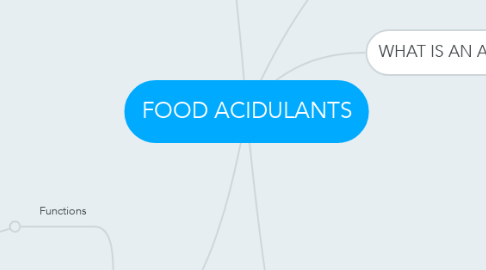
1. Flavour adjuncts
1.1. Functions
1.1.1. add tartness required to balance the excessive sweetness
1.2. Differents acids has different flavour profile
1.2.1. Acetic acid gives vinegar note ,it would not enhance a delicately flavoured fruit beverage
1.2.2. Citric acid gives a sharp dean bite but the acid taste dissipate quickly with citric acid
1.2.3. the acid taste lingers with fumaric acids
1.2.4. the acidity of malic acids builds slowly but the lingers
1.3. Modify or enhance food flavours
1.3.1. Enhancement of flavour require combination of the flavour with appropiate acids
2. TYPES OF ACID
2.1. ORGANIC ACID
2.1.1. Carboxylic acid
2.1.1.1. Monocarboxylic acid
2.1.1.1.1. EXAMPLE: Acetic acid,Propanoic acid ,Lactic acid
2.1.1.2. Dicarboxylic acid
2.1.1.2.1. EXAMPLE : Malic acid ,Tartaric acid,Adipic acid,Fumaric acid
2.1.1.3. Tricarboxylic acid
2.1.1.3.1. EXAMPLE : Citric acid
2.1.2. Phenolic acid
2.1.2.1. EXAMPLE : Benzoic acid
2.1.3. Fatty acid
2.1.3.1. EXAMPLE: Sorbic acid ,Caprylic acid,Butyric acid
2.1.4. Lactones
2.1.4.1. EXAMPLE : Ascorbic acid,Gluconolactone
2.1.5. Amino acids
2.2. INORGANIC ACID
2.2.1. EXAMPLE :Phosphoric acid,Hydrocholoric acid,Sulfuric acid
3. modify and enhance flavor
4. WHAT IS AN ACID?
4.1. acidulants functions in food and beverages products
4.2. FUNCTIONS:
4.2.1. provide sourness
4.2.2. lower the pH in order to retard microbial growth,to gel products containing pectin
4.2.3. increase buffer capacity
4.2.4. improve the texture and machinability of tortillas
5. FUNCTIONS
5.1. maintain the acidic pH & tartness in carbonated drinks
5.2. pH control
5.2.1. obtain desired gel
5.2.2. leavening action of carbon dioxide
5.2.3. sustain Malolactic fermentation-conversion [f Malic acid to Lactic acid
5.2.4. benefit for the products that used preservatives
5.2.5. maintain acidic fermentation process by including the buffering
5.2.6. *Buferring: ability of a weak acid/salt combination to control the amount of the hydrogen ions (provide protection from pH -dependent effects like colour or flavour changes
5.2.6.1. can stop growth of enhance the effectiveness of heat sterilization or the antimicrobial effect of solutes
5.3. preservatives
5.3.1. serve as antbrowning agents to maintain normal flavour ,colour and texture
5.4. chelating agents /antioxidants synergist
5.4.1. Metals such as ,nickel ,etc promote oxidative reactions by producing undesirable reactions such as discolouration ,rancidity and instability of nutrients
5.4.2. Chelation :ability of acidulants to form ring structure with metal ions
5.4.3. Sequestration : formation of stable ,water -soluble chelate
5.4.4. Retading the enzymic browning of fruits&vege
5.4.5. used as synergist for antioxidants
5.4.6. Citric acid: strongest chelating agent
5.4.7. Lactic acid
5.4.8. Malic acid
